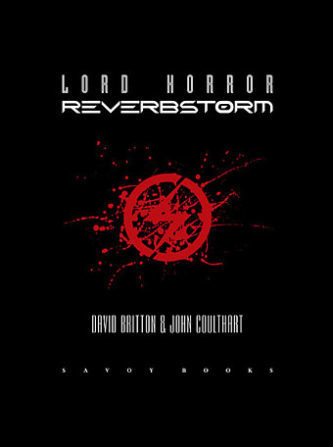 By DAVID BRITTON, JOHN COULTHART (Savoy Books; 2012)
By DAVID BRITTON, JOHN COULTHART (Savoy Books; 2012)
A graphic novel rendering of the notorious Lord Horror mythos that shows up most of today’s purveyors of “extreme horror” as the poseurs they are. It continues the tradition of previous Lord Horror media in its nonlinear storytelling and overpowering concentration on ugliness and disgust (although REVERBSTORM is somewhat unique in the Lord Horror lexicon in that it doesn’t contain “Fuck” in its title—unlike FUCK OFF AND DIE, MOTHERFUCKERS and BAPTISED IN THE BLOOD OF MILLIONS: A NOVEL OF FUCKING HOLOCAUST TERROR).
REVERBSTORM, which originally appeared as an eight issue comic series from 1990-2012, is distinguished from its predecessors by one crucial aspect: the astounding black and white artwork by John Coulthart. Coulthart’s gorgeous dark-hued art was previously featured in the H.P. Lovecraft-inspired graphic anthology THE HAUNTER OF THE DARK, but his work here (as he himself has acknowledged) goes far beyond anything in that volume, or anything else he’s done, in its depictions of up-close eviscerations, otherworldly creatures, outré architecture and bold samplings of Seurat’s “A Sunday Afternoon on the Island of La Grand Jatte” and Picasso’s “Guernica,” details from which are layered into the artwork.
The setting of REVERBSTORM is the imaginary city Torenbürgen, a hallucinatory playground for Lord Horror and his minions that’s packed with wonton bloodletting and Lovecraftian creatures. Lord Horror, for those unfamiliar with the earlier volumes, is a fascistic politician in an alternate universe where the Nazis have taken over the world. The character is based on William Joyce, a.k.a. “Lord Haw-Haw,” an American-Irish-British fascist notorious for broadcasting Nazi propaganda during WWII. Another real-life personage referenced in these pages is Jessie Matthews, a British singer/actress popular in the 1930s who appears here as Lord Horror’s wife, while James Joyce, whose words are widely quoted (actual pages from FINNEGAN’S WAKE turn up throughout), is Horror’s brother.
As is his custom, author David Britton seems determined to offend absolutely everybody. If the lovingly depicted dismemberments, eviscerations and sex scenes don’t upset you than the flippant anti-Semitism of Lord Horror and his minions just might, and if that doesn’t phase you than there’s the relentless nonlinearity of the piece, which has no real narrative to speak of, and indeed often feels like a portfolio rather than a proper graphic novel.
Then there are the literary and artistic references (to the aforementioned James Joyce, T.S. Eliot, Aubrey Beardsley, etc), which are so copious an eleven page appendix is included to explain them—and which will doubtless go clear over the heads of 99 percent of REVERBSTORM’S readers. The problem is that a knowledge of those references is necessary to fully understand the proceedings, which are as extreme as just about anything you’ll find, but contain a real fire and intelligence. It’s just a shame that this book’s ideal audience is so limited as to be all-but nonexistent.
